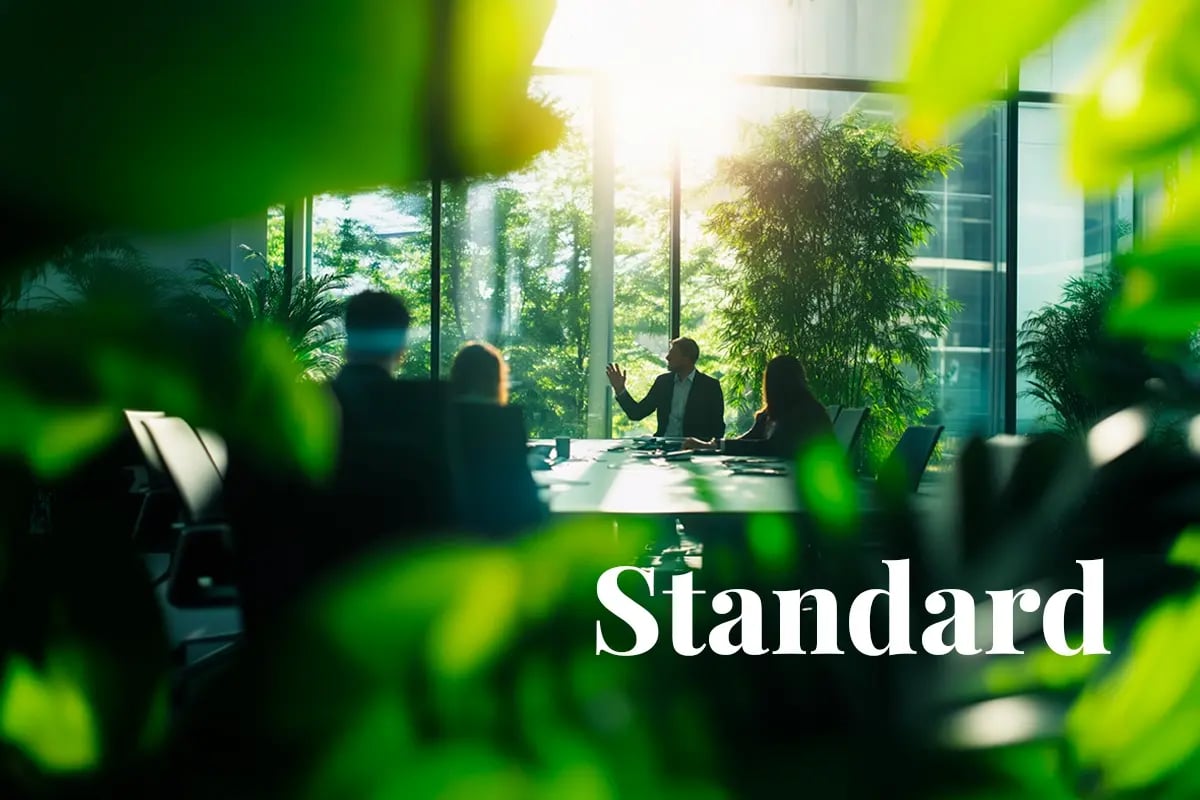The Science Based Targets initiative (SBTi) has released a draft revision of its Corporate Net-Zero Standard, marking a pivotal moment for corporate environmental strategy and the carbon removal sector. The draft—Corporate Net-Zero Standard Version 2—was published on 18 March and is now open for public consultation until 1 June.
 An office scene framed by greenery, with employees during a meeting. AI generated picture.
An office scene framed by greenery, with employees during a meeting. AI generated picture.
The updated framework aims to refine how companies align with 1.5°C pathways, offering new clarity on residual emissions, emissions scopes, and the integration of carbon dioxide removal (CDR). The biggest shift? For the first time, companies are formally invited to incorporate CDR into their net-zero targets using defined structures and thresholds.
Ben Rubin, Executive Director of the Carbon Business Council, highlighted the evolution: ‘This approach builds upon the neutralisation concept introduced in Version 1.0 of the SBTi Corporate Net-Zero Standard... These targets progressively increase the volume of removals over time at a rate consistent with reaching 100% of residual emissions being matched by a corresponding level of removals at the net-zero target year.’
The draft lays out three options for companies to integrate CDR, which encompass two different approaches: ‘removals targets and addressing residual emissions through additional abatement or removals’. Options 1 and 2 which propose separate removal targets, build upon ‘the neutralisation concept introduced in Version 1.0 of the SBTi Corporate Net-Zero Standard’. Under Option 1 ‘companies are required to set near- and long-term removal targets, in addition to abatement targets, to address any projected residual emissions in the net-zero target year.’ Conversely, under Option 2 ‘companies are recognised for setting near- and long-term removal targets, in addition to reduction targets, to address any projected residual emissions in the net-zero target year.’ The second approach addresses residual emissions addressed through additional abatement or removals. This means that rather than mandating an additional removal target, companies have the flexibility to address projected residual emissions.
However, the proposal is not without criticism. CDR and environmental policy expert Robert Höglund noted: ‘The just-published draft SBTi Net Zero standard is unlikely to significantly increase demand for CDR... A Scope-1 only requirement means few companies are likely to buy CDR, and net zero fulfilments would be jeopardised.’
Read more: New carbon tax measures in South Africa to drive local offsets
Höglund’s concern reflects a broader tension in the draft’s scope-specific approach. The proposed standard applies direct requirements to Scope 1 emissions—those from a company’s own operations—but leaves Scope 3 emissions, which often make up the largest share of a company’s footprint, more loosely defined. Instead of fixed reductions, the draft encourages targets for procurement or revenue alignment in emissions-intensive sectors, giving companies more leeway where they have less control.
For Scope 2 emissions, the SBTi proposes a clear deadline: companies must fully transition to low-carbon electricity no later than 2040.
To support global environmental initiatives, the draft also introduces tailored requirements for SMEs and businesses in emerging markets, simplifying compliance while maintaining ambition. A key addition is the emphasis on tracking and disclosing progress, enhancing transparency and celebrating leadership.
Margaret Kim, CEO of Gold Standard, welcomed the update: ‘We welcome SBTi’s focus on ongoing emissions and beyond value chain mitigation... Gold Standard remains committed to linking ambition to action, through market mechanisms that deliver verified impact for both people and the planet.’
The SBTi confirmed that companies already working under the current standard (V1.2) will receive a structured transition pathway to adapt to the new framework once finalised.
As consultation begins, the sector watches closely. The potential for carbon removal to scale will depend not only on what’s written in the standard—but on how far companies are willing to go.
Read more: Carbon project financing: why carbon finance is the smartest bet for future-proof investing
As global standards like SBTi evolve to formally integrate carbon removals and increase transparency in environmental strategies, the spotlight is shifting toward tangible, high-impact solutions. At DGB Group, we’re pioneering large-scale nature-based projects that deliver durable, verifiable carbon removals—exactly the kind of outcomes future-focused frameworks now call for. For companies preparing to meet more rigorous net-zero standards, our premium carbon units offer a powerful way to address residual emissions while restoring nature and supporting communities. Want to stay ahead of the curve? Discover how our solutions can help you align with tomorrow’s nature benchmarks today.




